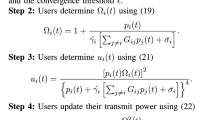Abstract
In this paper, we propose and analyze a simple adaptive uplink power control scheme, called two-level channel inversion, for data traffic in a cellular CDMA system. The basic idea is to reduce out-cell interference by reducing the rate of, or even suspending, transmission when the wireless channel is in a bad condition. We first describe the scheme in detail, and then present a probabilistic analysis model for evaluating the system performance. With this model, we determine the queueing delay and system throughput. Numerical results show that in comparison with the traditional channel inversion scheme, the two-level channel inversion scheme can substantially improve system throughput at a moderate cost of extra queueing delay. Finally, we present a design algorithm to optimize the overall performance while maintaining each user's quality of service (QoS).
Similar content being viewed by others
REFERENCES
S. V. Hanly, “An algorithm for combined cell-site selection and power control to maximize cellular spread spectrum capacity,” IEEE Journal On Selected Areas In Communications, vol. 13, pp. 1332-1340, September 1995.
R. Yates, “A framework for uplink power control in cellular radio systems,” IEEE Journal On Selected Areas In Communications, vol. 13, pp. 1341-1347, September 1995.
C. Y. Huang and R. D. Yates, “Rate of convergence for minimum power assignment algorithm in cellular radio system,” Wireless Networks, vol. 4, pp. 223-231, April 1998.
C. W. Sung and W. S. Wong, “The convergence of an asynchronous cooperative algorithm for distributed power control in cellular systems,” IEEE Transactions on Vehicular Technology, vol. 48, pp. 563-570, March 1999.
K. S. Gilhousen, I. M. Jacob, R. Padovani, A. J. Viterbi, Jr., L. A. Weaver, and C. E. Wheatley III, “On the capacity of a cellular CDMA system,” IEEE Transactions on Vehicular Technology, vol. 40, no. 2, pp. 303-312, May 1991.
A. J. Viterbi, A. M. Viterbi, and E. Zehavi, “Other-cell interference in cellular power-controlled CDMA,” IEEE Transactions On Communications, vol. 42, no. 2/3/4, pp. 1501-1504, 1994.
L. L. H. Andrew, “Measurement-based band allocation in multiband CDMA,” in Proc. IEEE INFOCOM, New York City, NY, 1999.
L. Ding and J. S. Lehnert, “Performance analysis of an uplink power control using truncated channel inversion for data traffic in a cellular CDMA system,” in Proc. IEEE Vehicular Technology Conference, May 2000.
A. J. Goldsmith and S. G. Chua, “Variable-rate variable-power MQAM for fading channels,” IEEE Transactions On Communications, vol. 45, no. 10, pp. 1218-1230, Oct 1997.
M. F. Neuts, Matrix geometric solutions in stochastic models, The Johns Hopkins University Press, Baltimore, MD, 1981.
M. Schwartz, Telecommunication networks: protocols, modeling and analysis, Addison-Wesley Publishing Company, 1988.
E. P. C. Kao, An introduction to stochastic processes, Duxbury Press: Wadsworth Publishing Company, 1996.
S. Ross, Stochastic Process, John Wiley & Sons, 1997.
Author information
Authors and Affiliations
Rights and permissions
About this article
Cite this article
Ding, L., Lehnert, J.S. Power Control Using Two-Level Channel Inversion for Data Traffic in a Cellular CDMA System: Performance and Optimal Design. International Journal of Wireless Information Networks 7, 115–132 (2000). https://doi.org/10.1023/A:1009535627929
Issue Date:
DOI: https://doi.org/10.1023/A:1009535627929




